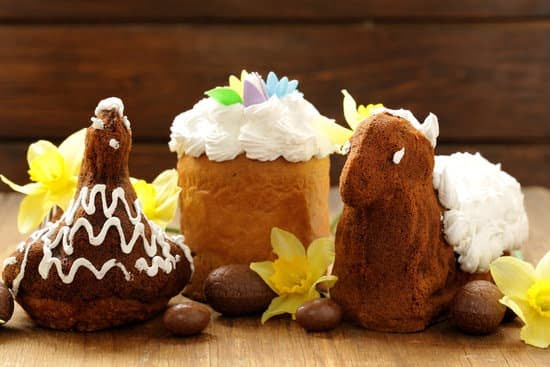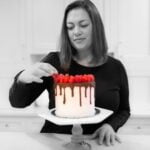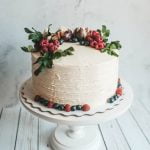Decorating a chocolate cake with fondant is a wonderful way to elevate its visual appeal and create a stunning centerpiece for any occasion. Fondant is a smooth, pliable icing made from sugar and water that can be rolled out and draped over cakes to create a flawless finish. It has gained popularity among cake decorators worldwide due to its versatility and ability to achieve professional-looking results.
Fondant provides an ideal canvas for creativity, allowing decorators to mold and shape it into intricate designs, flowers, figures, and textures. It offers a smooth and polished look that can transform a simple chocolate cake into an elegant masterpiece. Whether you’re looking to create a birthday cake, wedding cake or celebratory dessert, working with fondant opens up endless possibilities for design and decoration.
With the proper techniques and tools, anyone can learn how to decorate a chocolate cake with fondant. In this article, we will guide you through the process of working with fondant step-by-step. From understanding the basics of gathering essential tools and ingredients to covering the cake flawlessly and creating various decorations, we will provide you with all the information you need to create your own beautifully decorated chocolate cake.
Whether you’re an experienced baker or a novice in the kitchen, decorating cakes with fondant is an enjoyable activity that allows you to express your creativity while impressing your guests with stunning results. So let’s dive in and discover the world of fondant decoration together.
Understanding the Basics
To successfully decorate a chocolate cake with fondant, it is important to gather all the essential tools and ingredients beforehand. Here is a list of the items you will need:
- Fondant: It goes without saying that fondant is the star ingredient when it comes to decorating cakes. You can either make your own fondant or purchase pre-made fondant from a baking supply store. When choosing fondant, opt for a high-quality brand that offers a smooth texture and easy workability.
- Rolling Pin: A sturdy rolling pin is essential for rolling out the fondant to the desired thickness. Make sure to choose a rolling pin with non-stick surfaces or cover your rolling pin with plastic wrap to prevent sticking.
- Cake Smoother: A cake smoother is used to smooth out any air bubbles or wrinkles in the fondant while covering the cake. It helps achieve that pristine, professional finish on your cake.
- Pizza Cutter or X-Acto Knife: These tools are handy for trimming excess fondant from around the base of the cake once it’s covered.
- Fondant Mat or Non-Stick Surface: To prevent sticking and provide an easy surface for rolling out your fondant, use a silicone or non-stick mat specifically designed for working with fondant.
- Cornstarch or Powdered Sugar: Dusting your work surface with cornstarch or powdered sugar helps prevent sticking while working with fondant.
- Edible Food Colors: Depending on your design vision, you may want colored fondant for decorations or accents. Use gel-based food coloring specifically formulated for use with fondant to achieve vibrant shades without altering the consistency of the dough.
- Fondant Tools (optional): While not essential, these tools can be helpful for creating intricate designs and textures on your cake, such as embossing tools, modeling tools, and veining tools.
These are just some of the essential tools and ingredients you will need for decorating a chocolate cake with fondant. It’s important to have everything prepared before starting the decoration process to ensure a smooth and enjoyable experience. You can find these tools and ingredients at specialty baking stores, local craft stores, or online retailers that sell baking supplies.
Preparing the Cake
Baking the perfect chocolate cake sets the foundation for a beautifully decorated cake with fondant. Here is a simple yet scrumptious chocolate cake recipe that works well with fondant:
Ingredients:
- 2 cups all-purpose flour.
- 2 cups granulated sugar.
- 3/4 cup unsweetened cocoa powder.
- 1 1/2 teaspoons baking powder.
- 1 1/2 teaspoons baking soda.
- 1 teaspoon salt.
- 2 large eggs.
- 1 cup whole milk.
- 1/2 cup vegetable oil.
- 2 teaspoons vanilla extract.
- 1 cup boiling water.
Instructions:
- Preheat your oven to 350°F (175°C). Grease and flour two round cake pans.
- In a large mixing bowl, combine the flour, sugar, cocoa powder, baking powder, baking soda, and salt.
- Add the eggs, milk, oil, and vanilla extract to the dry ingredients. Mix on medium speed until well combined.
- Pour in the boiling water and mix until smooth batter forms.
- Divide the batter evenly between the prepared cake pans.
- Bake for approximately 30 to 35 minutes or until a toothpick inserted into the center comes out clean.
- Remove from oven and let cool in the pans for about 10 minutes before transferring to wire racks to cool completely.
It is crucial to allow the cake layers to cool completely before starting the decoration process. This ensures that the fondant will not melt or become too soft when applied. If necessary, you can wrap each cooled layer in plastic wrap and refrigerate them for an hour or two before decorating.
Remember that proper cooling also helps prevent any moisture from accumulating on the surface of the cake, which could affect how well the fondant adheres.
| Baking Tips: | Tricks for cooling the cake: |
|---|---|
| – Double-check your oven temperature with an oven thermometer to ensure accurate baking results. | – Place the cake pans on wire racks to allow air circulation and faster cooling. |
| – Use quality cocoa powder for a rich chocolate flavor. | – If you’re short on time, you can place the cake layers in the refrigerator for 30 minutes to expedite the cooling process. |
| – Sift dry ingredients together to remove lumps and ensure a smooth batter. | – Avoid stacking hot cake layers on top of each other as this can cause condensation and make them sticky. |
By following these steps and tips, you will have a perfectly baked chocolate cake ready for its fondant decoration adventure.
Preparing the Fondant
Once you have gathered all the necessary tools and ingredients, it’s time to prepare the fondant for decorating your chocolate cake. Properly kneading and coloring the fondant will ensure that it is smooth, pliable, and ready to be shaped into beautiful decorations.
To begin, follow these steps for kneading fondant:
- Start with a clean work surface: Clear a clean and lightly greased countertop or cutting board to work on. This will prevent the fondant from sticking and make it easier to handle.
- Cut the desired amount of fondant: Depending on the size of your cake and the decorations you plan to make, cut off a piece of fondant that will be sufficient for your needs.
- Warm up the fondant: Roll the fondant in your hands or between your palms to warm it up slightly. This will make it more pliable and easier to work with.
- Start kneading: Begin by pressing down firmly on the fondant with the palms of your hands. Fold it over and then press down again. Repeat this motion continuously for about 5-7 minutes.
- Monitor consistency: As you knead, pay attention to the texture of the fondant. If it becomes too sticky, sprinkle some powdered sugar onto your work surface and continue kneading until it reaches a smooth, elastic consistency.
Now that the fondant is properly kneaded, you can proceed with coloring it:
- Divide into portions: If you want to create different colors for various decorations, divide the main portion of kneaded fondant into smaller sections.
- Use gel food coloring: Gel-based food coloring works best for tinting fondant as it adds vibrant hues without affecting its texture. Add a small amount of gel coloring at a time using a toothpick or skewer and gradually mix it into each portion until the desired shade is achieved.
- Protect your hands: To prevent staining your hands, wear food-safe gloves or use a plastic wrap to cover your hands while kneading in the color. This will also help distribute the color evenly throughout the fondant.
- Test color intensity: Before committing to a full batch of colored fondant, test a small amount to ensure you are satisfied with the intensity of the shade. Adjust as needed by adding more coloring or kneading in some plain white fondant to lighten it.
By following these steps for kneading and coloring fondant, you will have a smooth and vibrant base for creating your decorative elements. Now you’re ready to move on to covering your chocolate cake with fondant.
Covering the Cake with Fondant
Once you have gathered all of your tools and ingredients, it’s time to move onto the exciting part – covering the chocolate cake with fondant. This step-by-step guide will walk you through the process and help you achieve a flawless finish.
Step 1: Prepare Your Cake
Before beginning the fondant application, make sure your chocolate cake is completely cooled. Warm cakes can cause the fondant to melt or become too soft, resulting in a messy finished product. If needed, trim any uneven edges or domed tops from your cake to create a smooth surface.
Step 2: Apply a Base Coat
To ensure that the fondant adheres well to your cake, apply a thin layer of buttercream frosting as a base coat. This acts as an adhesive and smooths out any imperfections on the surface of your cake. Use an offset spatula to spread an even layer of frosting over the entire cake.
Step 3: Roll Out Your Fondant
Dust your work surface with powdered sugar or cornstarch to prevent sticking. Take a portion of fondant large enough to cover your cake and knead it until it becomes soft and pliable. Roll out the fondant into a circle or rectangle shape, depending on the size and shape of your cake.
Step 4: Drape Fondant Over Cake
Gently lift the rolled-out fondant using a rolling pin or by loosely folding it in half, then draping it over your cake. Begin smoothing out the fondant from the center towards the edges using gentle downward motions with your hands. Be careful not to stretch or tear the fondant as you work.
Step 5: Smooth and Trim Excess Fondant
Using your hands or a smoother tool, gently smooth out any wrinkles or air bubbles that may have formed on top of the fondant. Trim off any excess fondant using a sharp knife or pizza cutter, following the edge of the cake as a guide.
Step 6: Finishing Touches
Now that your cake is covered in fondant, you can further enhance its appearance by adding decorative elements. Use additional fondant to create borders, patterns, or other designs that complement the theme of your cake. You can also use molds or cookie cutters to create shapes for additional embellishments.
By following this step-by-step guide, you will be able to confidently cover your chocolate cake with fondant and achieve a professional-looking result. Remember to take your time and have fun with the process. The next section will delve into creating fondant decorations such as flowers, figures, and intricate designs to take your cake decorating skills to the next level.
Creating Fondant Decorations
One of the most exciting aspects of decorating a chocolate cake with fondant is the ability to create beautiful and intricate decorations. Fondant allows for endless creativity and can be molded into various shapes, making it perfect for crafting flowers, figures, and unique designs. In this section, we will explore different techniques for creating fondant decorations and provide step-by-step instructions along with accompanying images.
Flowers
- Start by coloring your fondant in the desired shades for your flowers. Use gel food coloring or powdered food coloring for best results.
- Knead the fondant until it reaches a pliable texture.
- Roll out the fondant thinly on a clean surface using a rolling pin dusted with powdered sugar or cornstarch to prevent sticking.
- Use flower-shaped cookie cutters or create your own templates to cut out flower shapes from the rolled-out fondant.
- Use a ball tool or your fingers to gently thin out the edges of each petal to give them a more realistic look.
- To add dimension to your flowers, place them on foam shaping pads and use embossing tools or the back of a paintbrush to create texture on the petals.
- Allow your flowers to dry completely before placing them on the cake.
Figures
- To create figures such as animals or characters, start by forming smaller pieces of fondant into basic shapes that represent different body parts (e.g., head, arms, legs).
- Use edible glue or water as an adhesive to attach these body parts together.
- Sculpt additional details onto each body part using tools like toothpicks or small brushes dipped in food coloring.
- Allow your figures to dry for several hours before placing them on the cake.
Designs
- For more intricate designs, such as lace patterns or intricate borders, roll out fondant into thin sheets and cut out the desired shapes using special fondant design cutters or stencils.
- Attach the designs to the cake using edible glue or water.
- If you want to create a three-dimensional effect, use gum paste or a mixture of fondant and tylose powder to make your designs. This ensures they dry more rigidly and hold their shape.
- Another technique for creating designs is piped royal icing. Use a small round piping tip to pipe intricate patterns onto the cake. Allow the icing to dry before adding any additional decorations.
By following these techniques and experimenting with different colors, shapes, and sizes, you can easily create stunning fondant decorations for your chocolate cake. Remember to take your time and have fun with the process – fondant decoration is an art that allows for limitless creativity.
Adding Finishing Touches
Once you have successfully covered your chocolate cake with fondant, it’s time to take your decoration to the next level by adding finishing touches. These final details will elevate the overall appearance of your cake and make it truly stand out. In this section, we will explore different techniques such as painting, texturing, and using luster dust to achieve a professional and polished look.
One way to enhance the visual appeal of your fondant-covered cake is by using edible paint. Edible paints are available in a wide range of colors and can be used to add intricate designs or patterns to your cake. To use edible paint, simply dip a clean brush into the desired color and start painting on the surface of the fondant.
You can create designs such as flowers, leaves, or abstract shapes. Experiment with different techniques like dry brushing or watercolor effects to achieve unique results.
Another technique that can significantly enhance the texture of your cake is embossing or texturing. This involves using tools specifically designed for creating patterns on fondant. You can find various embossing tools at baking supply stores or online retailers. Simply press the tool onto the surface of the fondant and gently move it around to create an embossed pattern. This technique works great for creating textured backgrounds or adding depth to specific areas of your design.
To add a touch of sparkle and elegance, luster dust is a fantastic option. Luster dust is a non-toxic powdered coloring that gives a shimmering effect when applied to fondant. It comes in various shades such as gold, silver, pearl, and more. To use luster dust, simply dip a clean brush into the powder and gently tap off any excess before applying it onto the fondant surface. Use gentle strokes to spread the dust evenly across the desired area.
By incorporating these finishing touches into your chocolate cake with fondant, you can create a remarkable and visually stunning dessert. Remember to practice and experiment with different techniques to find your unique style. The possibilities are endless when it comes to painting, texturing, and using luster dust on fondant-covered cakes. So, let your creativity flow and enjoy the process of making edible art that will surely impress your friends and family.
Trouble Shooting
Problem: Fondant Cracking or Tearing
One common challenge that cake decorators may face when working with fondant is cracking or tearing. This can happen when the fondant is not properly kneaded or rolled out, causing it to become too dry and brittle. To prevent this issue, make sure to knead the fondant until it is smooth and pliable before rolling it out.
If the fondant starts to crack while rolling, stop and re-knead it to warm it up and make it more flexible. Additionally, ensure that you roll out the fondant to an even thickness and use a non-stick surface or cornstarch to prevent sticking.
If cracks or tears still occur despite these precautions, there are solutions to salvage your decoration. Gently smooth down the fondant around the affected area using your fingers or a small decorating tool. You can also strategically place additional decorations over the cracked areas to mask them. For larger tears, use a small piece of fondant as a patch by dampening it slightly with water or edible adhesive and pressing it onto the tear.
Problem: Fondant Bulging or Wrinkling
Another common issue that can arise when covering a cake with fondant is bulging or wrinkling. This occurs when air pockets get trapped between the cake and the fondant, causing unsightly bumps and wrinkles on the surface. To prevent this problem, make sure that your cake is levelled and has a smooth surface before applying the fondant. Trim any uneven edges or domed tops if necessary.
To further minimize bulging, apply a thin layer of buttercream icing on top of the cake before covering it with fondant. This will act as an adhesive and help seal any gaps between the cake layers. Additionally, lightly press down on the top of the covered cake as you smooth out any air bubbles from underneath the fondant. If wrinkles still occur, use a fondant smoother or a clean, flat object to gently smooth them out.
Problem: Fondant Color Fading
One challenge that decorators may encounter is fading of fondant colors over time. This can happen when cakes are exposed to direct sunlight or certain lighting conditions, causing the colors to lose their vibrancy. To prevent color fading, it is recommended to store decorated cakes in a cool and dark place until they are ready to be served.
If you notice color fading on your fondant decorations, there are options for retouching or enhancing the colors. One technique is airbrushing food-safe coloring onto the faded areas to restore their original vibrancy. You can also use edible petal dusts or luster dusts to add subtle shading or shimmer effects to revive the colors. Additionally, consider applying a thin layer of clear piping gel over the decorations for added protection and shine.
By being aware of these common challenges and having solutions at hand, cake decorators can tackle any issues that arise during the fondant decoration process and achieve beautiful results with their chocolate cakes. Remember to practice patience, experiment with different techniques, and most importantly, have fun with your creations.
Final Thoughts
When it comes to decorating a chocolate cake with fondant, the possibilities are endless. Fondant allows for creativity and customization, making each cake unique and special. As you finish decorating your cake with fondant, it’s time to showcase your masterpiece and encourage further creativity. Here are some final thoughts on showcasing the finished cake and exploring new design ideas.
Showcasing Your Finished Cake
After putting in all the hard work and effort into decorating your chocolate cake with fondant, it’s important to display it in the best way possible. Choose a beautiful cake stand or platter that complements the color scheme and overall design of your cake. Make sure to place it in a well-lit area where the details of your fondant work can truly shine.
Consider setting up a dedicated space or table for your finished cake, complete with some decorations that match the theme or occasion. This will create an inviting display that will impress guests and make them eager to try a slice of your delicious creation.
Encouraging Creativity
Now that you have successfully decorated a chocolate cake with fondant, don’t be afraid to push the boundaries of your creativity. Fondant allows for endless possibilities when it comes to designs and decorations. Experiment with different shapes, colors, and techniques to create unique cakes for various occasions.
Challenge yourself by trying out more advanced techniques such as sculpting figures or creating intricate designs on your cakes. Learn from online tutorials or take classes to expand your skills and knowledge in the world of fondant decoration.
Remember, practice makes perfect. Don’t be discouraged if your first attempts don’t turn out exactly as planned. Keep practicing and refining your techniques, and soon enough you’ll be creating stunning fondant masterpieces.
Sharing Ideas
Joining baking forums or communities can be a great way to connect with other cake decorators who share the same passion. Share your finished cake and fondant designs with others, and be open to feedback and suggestions. This sharing of ideas can spark inspiration and help you discover new techniques or styles to try.
Additionally, consider entering cake decorating competitions or participating in local bake sales or events where you can showcase your talent. These opportunities can not only boost your confidence but also provide valuable exposure for your skills.
Conclusion
In conclusion, decorating a chocolate cake with fondant is an excellent way to elevate the cake experience and achieve beautiful and professional results. Fondant offers a smooth and flawless finish that can truly transform a simple chocolate cake into a work of art. After understanding the basics, such as gathering the necessary tools and ingredients, baking and cooling the cake, and preparing the fondant by kneading and coloring it properly, you are ready to cover the cake with fondant.
Covering the cake with fondant may seem daunting at first, but by breaking down the process into manageable steps and following detailed instructions, you can achieve a flawless finish. Additionally, you can take your cake decoration to the next level by creating intricate fondant decorations such as flowers, figures, or designs. Adding finishing touches like painting, creating textures, or adding luster dust can enhance the overall appearance of your cake and give it a professional touch.
It’s important to note that challenges may arise during the fondant decoration process. However, by identifying common issues and providing practical solutions and troubleshooting tips for each challenge, this article equips you with the knowledge to overcome any obstacles that come your way.
Ultimately, decorating a chocolate cake with fondant allows for endless creativity and customization. Once you’ve mastered the techniques discussed in this article, don’t hesitate to showcase your finished creations. Embrace your own unique ideas for customizing cakes and experimenting with different designs to truly make them your own.
So go ahead – try out these techniques and tips for decorating a chocolate cake with fondant. With practice and creativity, you’ll be able to create stunning cakes that not only look impressive but also taste delicious. Enjoy the process of creating edible works of art that will surely leave everyone in awe of your talent.
Frequently Asked Questions
How do you put fondant on a chocolate cake?
To put fondant on a chocolate cake, begin by preparing the cake itself. Allow it to cool completely before covering it with a thin layer of buttercream or ganache to create a smooth surface. Next, lightly dust your work surface and rolling pin with powdered sugar or cornstarch to prevent sticking. Roll out the fondant to the desired thickness, typically around 1/8 inch thick.
Slowly lift the rolled fondant using your rolling pin and gently drape it over the cake. Smooth it down with your hands, starting from the top and working your way down to the sides of the cake. Trim off any excess fondant using a sharp knife or pizza cutter and continue to smooth and shape until you achieve a flawless finish.
Can you decorate chocolate cake with fondant?
Yes, you can absolutely decorate a chocolate cake with fondant! Fondant is a versatile medium that allows for limitless creativity in cake decorating.
Once you have covered your chocolate cake with a smooth layer of fondant, you can proceed to add various decorative elements such as flowers, bows, patterns, or even sculpted figures made out of additional colored fondants. Fondant provides an ideal base for intricate designs and allows decorators to achieve a polished and professional look for their chocolate cakes.
How do you get fondant to stick to a cake?
Getting fondant to stick properly to a cake requires some preparation and technique. Before applying the fondant, make sure the surface of your cake is clean and free from any grease or crumbs by brushing off any loose particles. Apply a thin layer of buttercream frosting or ganache onto the cake as this will act as an adhesive for the fondant’s attachment.
Some decorators prefer brushing the surface with simple syrup instead of buttercream as it creates stickiness without altering flavors too much. Additionally, ensure that your rolled-out fondant is not too dry by adding just enough water or shortening if needed, which will help it adhere better to the cake’s surface when smoothed down. By following these steps, you can ensure that the fondant sticks securely to your cake, allowing for a flawless and professional finish.

Welcome to our cake decorating blog! My name is Destiny Flores, and I am the proud owner of a cake decorating business named Cake Karma. Our mission is to provide delicious, beautiful cakes for all occasions. We specialize in creating custom cakes that are tailored specifically to each customer’s individual needs and tastes.





